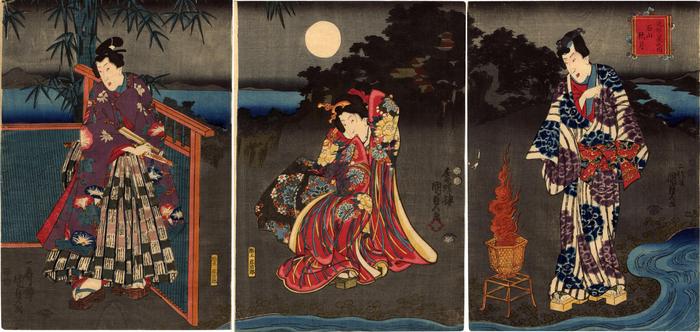Utagawa Kunisada II (二代歌川国貞) (artist 1823 – 1880)
Autumn Moon at Ishiyama Temple (Ishiyama shūgetsu - 石山秋月) from the series Eight Views of Ōmi (Ōmi hakkei no uchi - 近江八景之内)
1851
30 in x 14 in (Overall dimensions) color woodblock print; oban triptych
Signed on r.: Nidaime Kunisada ga
二代目国貞画
c.: Baichōrō Kunisada ga (梅蝶楼国貞画)
l.: Ichijusai Kunisada ga (一寿斎国貞画)
Publisher: Tsutaya Kichizō (Marks 556 - seal 03-004)
Carver: Horikō Shōjirō 彫工庄次郎
Censors: Mera, Watanabe
Museum of Fine Arts, Boston
Tokyo Metropolitan Library
Ritsumeikan University - right panel only
Museum für angewandte Kunst, Vienna - right panel
Museum für angewandte Kunst, Vienna - middle panel
Museum für angewandte Kunst, Vienna - left panel
Chazen Museum of Art - center panel
National Diet Library - right panel
National Diet Library - center panel
National Diet Library - left panel
Google maps - Ishiyama Temple near Lake Biwa
Nasjonalmuseet, Oslo - the right panel
Nasjonalmuseet, Oslo - the middle panel
National Museum in Krakow
Victoria and Albert Museum Illustrated in Genji's World in Japanese Woodblock Prints by Andreas Marks, et al., pl. 29, p. 95.
Mitsuuji on the right stands next to Tamakuzu [玉葛 or たまくず], "...the daughter of his former, now dead lover Tasogare and his childhood friend Takanao. Mitsuuji tries to catch a glimpse of her in the glow of the night lamp and the moon... In the background is a temple surrounded by a copse of trees and Lake Biwa."
****
The Museum für angewandte Kunst in Vienna postulates that the figure on the left is Sochi no miya, Mitsuuji's, i.e., Genji's, half-brother. If you look closely you will see that he is wearing an outer kimono which is beautifully decorated at the bottom with morning glory blooms and at the top with the sasarindō crest of the Genji/Minamoto clan.
Their curatorial files in translation say: "Two men and a woman on a full moon night on the shore of Lake Biwa. The Genji chapter mark that frames the title cartouche stands for the 23rd chapter of the Genji novel 源氏物語: Hatsune 初音. The scene depicted, however, seems to be more of an allusion to the 25th chapter (Hotaru 蛍) of the Genji novel, in which Genji releases fireflies (hotaru) to illuminate Tamakatsura's face during a nighttime rendezvous between Tamakatsura [たまかつら] and his half-brother. Here a man (Genji?) next to an open fire in a vessel."
****
Sebastian Izzard in Hiroshige: an exhibition of selected prints and illustrated books on page 41 notes: "The temple at Ishiyama, said to be the place where Murasaki Shikibu composed The Tale of Genji..."
****
The carver Hori Shōji is also known as Tsuge Shōjirō.
Tsutaya Kichizō (蔦屋吉蔵) (publisher)
Genji related prints (Genji-e - 源氏絵) (genre)
Ryūtei Tanehiko (柳亭種彦) (author)
